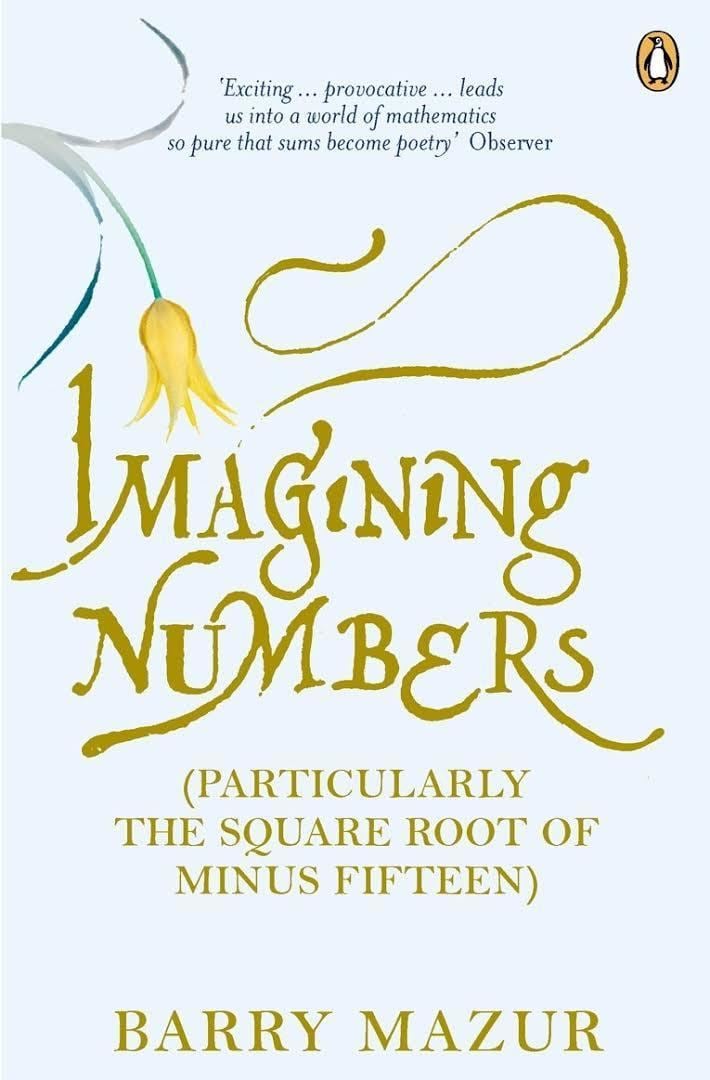6.8 /10 1 Votes
Country United States Publication date January 1, 2003 Pages 270 pp. Originally published 1 January 2003 Publisher Farrar, Straus and Giroux | 3.4/5 Goodreads Language English Media type Print ISBN 978-0374174699 | |||||||||||||||||||||||||||||||||
 | ||||||||||||||||||||||||||||||||||
Mathematics books Circles Disturbed: The Inter, The Best Writing on Mathemat, Mathematics and the Imagination, The Joy of X: A Guided T, The Princeton Compani | ||||||||||||||||||||||||||||||||||
Imagining numbers as shapes numberphile
Imagining Numbers: (particularly the square root of minus fifteen) is a 2003 book by mathematician Barry Mazur to show that mathematics in human society is durative by nature. The book was published by Farrar, Straus and Giroux.
Contents
Overview
In the preface, Mazur describes the target audience of the book:
"This book...is written for people who have no training in mathematics and who may not have actively thought about mathematics since high school, or even during it, but who may wish to experience an act of mathematical imagining and to consider how such an experience compares with the imaginative work involved in reading and understanding a phrase in a poem."In the conclusion, Mazur provides a window onto the value of mathematics for human endeavour:
The number i = √-1 is identified with the point whose coordinates are (0,1); that is, with the point 1 unit north of the origin. Recall that we chose to view "multiplication by √-1" as a rotation by 90 degrees counterclockwise about the origin.
A good test of whether we have understood this passage from complex numbers to points on the plane is to ask ourselves what would be different if we had identified "multiplication by √-1" as a rotation of the plane 90 degrees clockwise; or, what would be the same, 270 degrees counterclockwise? The brief answer here is that nothing whatsoever would change, except for the curious fact that i would be playing the role that -i plays in our identification, -i would be playing the role that i plays, and more generally, the complex number a – bi would be playing the role that a + bi plays. Behind this lies a surprise, and a curious mirror. There is no intrinsic (algebraic) way of distinguishing +√-1 from -√-1. Each of them, of course, is a square root of −1. The only distinction between them is given by their names, and our choosing to put +i north of the origin and -i south of it. We could have reversed our choice, provided we kept track of that, and worked consistently with this other choice. These entities, +i and -i, are twins, and the only breaking of their symmetry comes from the way in which we name them. Imagine the analogous moment when parents of newly born identical twins choose names for their two children, thereby making the first, and immensely important, distinction between them. A reader of an early draft of this book asked why I called +i and -i twins, but did not, for example, call +1 and −1 twins. Here is why. The number +1 is distinguished from the number −1 by some purely algebraic property (for example, it is equal to its square), while there is no analogous property, described entirely in terms of addition and multiplication, that distinguishes +i from -i and yet does not, either directly or indirectly, make use of the names we gave to them.
abiabiconjugatesreversing the sign of the imaginary part of a complex numberis a basic symmetry of the complex number system.
Barry Mazur, Imagining Numbers (Particularly the Square Root of Minus Fifteen), Chapter 12, pp215–7
